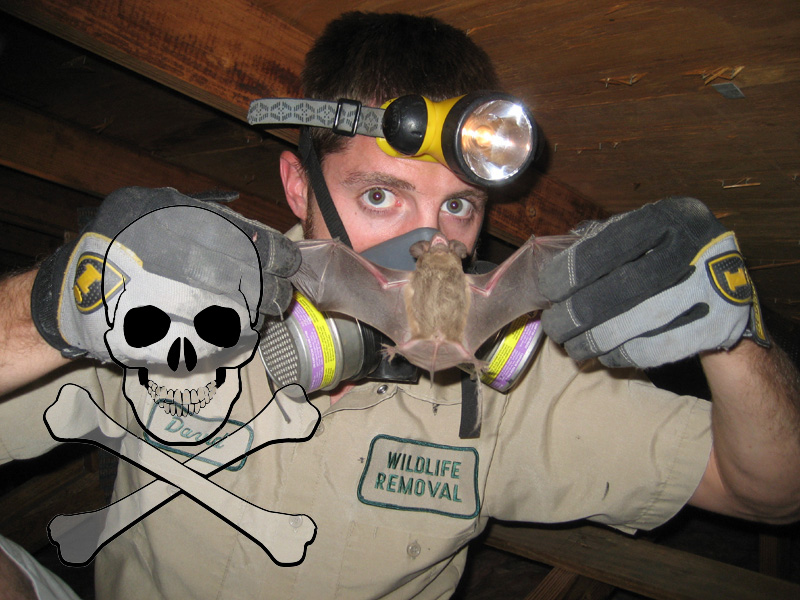- USA Wildlife Removal Education Guide and Resources
Are Bats Dangerous To Humans, Cats, Or Dogs?

The short answer is "not usually". It's true that most cases of
rabies transmission in the United States are due to bats. But
it's also extremely rare. If you've had a bat in your house, no
health professional is going to say "do nothing", because of
liability risk in America, where doctors practice "cover thy
ass" medicine. But the odds that the bat bit you are extremely
low, and the odds that it had rabies and infected you are
exceedingly low. That said, bats do carry a few other health
risks, more from parasites and droppings than from biting bats.
According to the US Fish and Wildlife Service more than over
fifty percent of the bat species are endangered, which is sad
when you consider that bats are environmentally helpful in
nature. The reason for such a decline is because their natural
habitat has been compromised with the expansion of cities and
people. Bats control the insect population by eating tons of
them every night. Without bats our world would be overwhelmed
with insects. They can eat over one thousand insects in an hour,
including disease carrying varmints such as mosquitoes. The bats
use a high frequency built in navigation system that can spot
out insects immediately. This makes it extremely easy for these
near blind creatures to fly and feed at the same time.
Some Bats Do Have Rabies - It is true that some species of bats carry rabies as do many small animals, but the cases that humans were infected with rabies are so small in comparison to other transmitted diseases that it creates very little threat. There have only been forty-four deaths from rabies in the last fifty-five years. Of these deaths only one was from the common house bat found in the United States. Most of the others were contributed to a tree roosting species. If a person is bitten by a bat or any wild animal it is best to clean the area and seek medical attention. If a bat is found on the ground than it may have rabies and should be left alone.
Airborne Diseases And Bats - Bats are known to carry a soil fungus called Histoplasma casulatum that can be found in the bats feces called guano. When large amounts of guano are disturbed the spores become airborne which humans can inhale when entering a bat roost. This will cause a disease called Histoplasmois which is a disease of the lungs. The disease can cause flu like symptoms and has been misdiagnosed as tuberculosis. To confirm that it is this disease requires a blood and skin test. Fortunately most cases of infections reported are found in highly humid areas within caves. The importance of having professionals clear out guano cannot be stressed enough as they have the equipment and clothing to prevent any exposure to the fungus.
Discovering Bats In Your House - Most house sightings of bats occur in the fall and are usually just one or two of them looking for a place to hibernate for the winter or looking for a place to set up home. If you see bats several times towards the end of summer then it is like that there is a colony nearby. This is about the time that babies begin to become independent and fly off. If a bat does come into the house the best thing to do is to open the windows and doors and let it out. Bats do not attack humans; on the contrary they do everything they can to avoid conflict.
Are Repellants necessary? - Very rarely is there a reason to repel bats. By allowing the bats to leave an area and having the guano cleaned out, then sealing off any entry points you will have discouraged any further problems. To use any chemical repellant requires a federal permit, as these animals are protected. In short, bats do not actually attack a person, so they are not dangerous in this way. In addition, a rabid bat is a rare occurrence. If you see a bat on the ground it is most likely sick-do not pick it up. The main danger a bat poses is in the diseases its guano or droppings carry.
Go back to the main Bat Removal page for more information about are bats dangerous to humans, cats, or dogs. You can also read morea bout bats in my educational articles. My years of experience allows me to offer you the best advice about the damage that bats can inflict and the potential danger of Bat Feces. I can give some pointers on what property modifications will keep down bat populations, and how to clean Bat Feces out of your Attic. Find out if a bat house prevents bats in your home and if the city or county animal services will help you with a bat problem.
Learn if a bright light or high pitch sound deterrent machine will work against bats, and if a bat in the attic will have a nest of babies. I can tell you if a pest control company will remove a bat, and if it is Legal to Trap a Bat. Learn how to Locate and Remove a Dead Bat and find out everything you need to know about Bat Exclusion Material. Learn about Bat Mating Habits and the summer maternity season, and even if bats make Good Pets.
Hear my thoughts on if you should ever Poison a Bat and find my best methods for how to get bats out of the attic. Learn, too, if mothballs or ammonia actually help repel bats.

